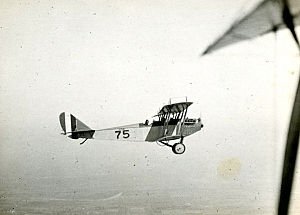Rich Field
| Rich Field | |
|---|---|
| Waco, Texas | |

Curtiss JN-4 flying from Rich Field, Waco, Texas, 1918
|
|
| Coordinates | 31°32′45″N 97°11′16″W / 31.54583°N 97.18778°WCoordinates: 31°32′45″N 97°11′16″W / 31.54583°N 97.18778°W |
| Type | Pilot training airfield |
| Site information | |
| Controlled by |
|
| Condition | Redeveloped into urban area |
| Site history | |
| Built | 1917 |
| In use | 1917–1945 |
| Battles/wars |
World War I World War II |
| Garrison information | |
| Garrison | Training Section, Air Service |
Rich Field is a former World War I military airfield, located in Waco, Texas, near what is now the intersection of Bosque Boulevard and 41st Street. It operated as a training field for the Air Service, United States Army from 1917 until 1919. The airfield was one of thirty-two Air Service training camps established in 1917 after the United States entry into World War I.
The base was named Rich Field in honor of 2nd Lt. C. Perry Rich of the Philippine Scouts. He was born in Indiana, and had been instructed to fly by Lt. Frank P. Lahm in May 1913, then crashed his Wright Model C into Manila Bay on November 14, the tenth U.S. pilot to die in a flying accident. Rich's body was recovered and was buried at Arlington National Cemetery, near other early aviators.
A contract was signed on August 24, 1917 giving the War Department title to the property, which was in private hands. Formerly cotton fields, a significant number of farm buildings on the property had to be torn down. A labor force of about 3,400, including 1,000 Mexican workers, erected buildings, poured concrete, and laid down pipes and an electrical system.
On September 17, 1917, the first officer reported for duty, and various pieces of equipment and a group of personnel were assigned to set up the base as a primary flight training field. The first shipment of 25 aircraft arrived on November 14 and were uncrated and assembled by the 150th Aero Squadron, moved from Kelly Field. Twenty-five flight cadets reported for training on Thanksgiving Day 1917, and flight instruction began on December 1. Eventually a total of 243 Standard J-1 trainers were assigned to Rich Field. In June 1918, the J-1s were replaced by the Curtiss JN-4 which was standardized by the War Department as the standard training plane for the Air Service.
...
Wikipedia

